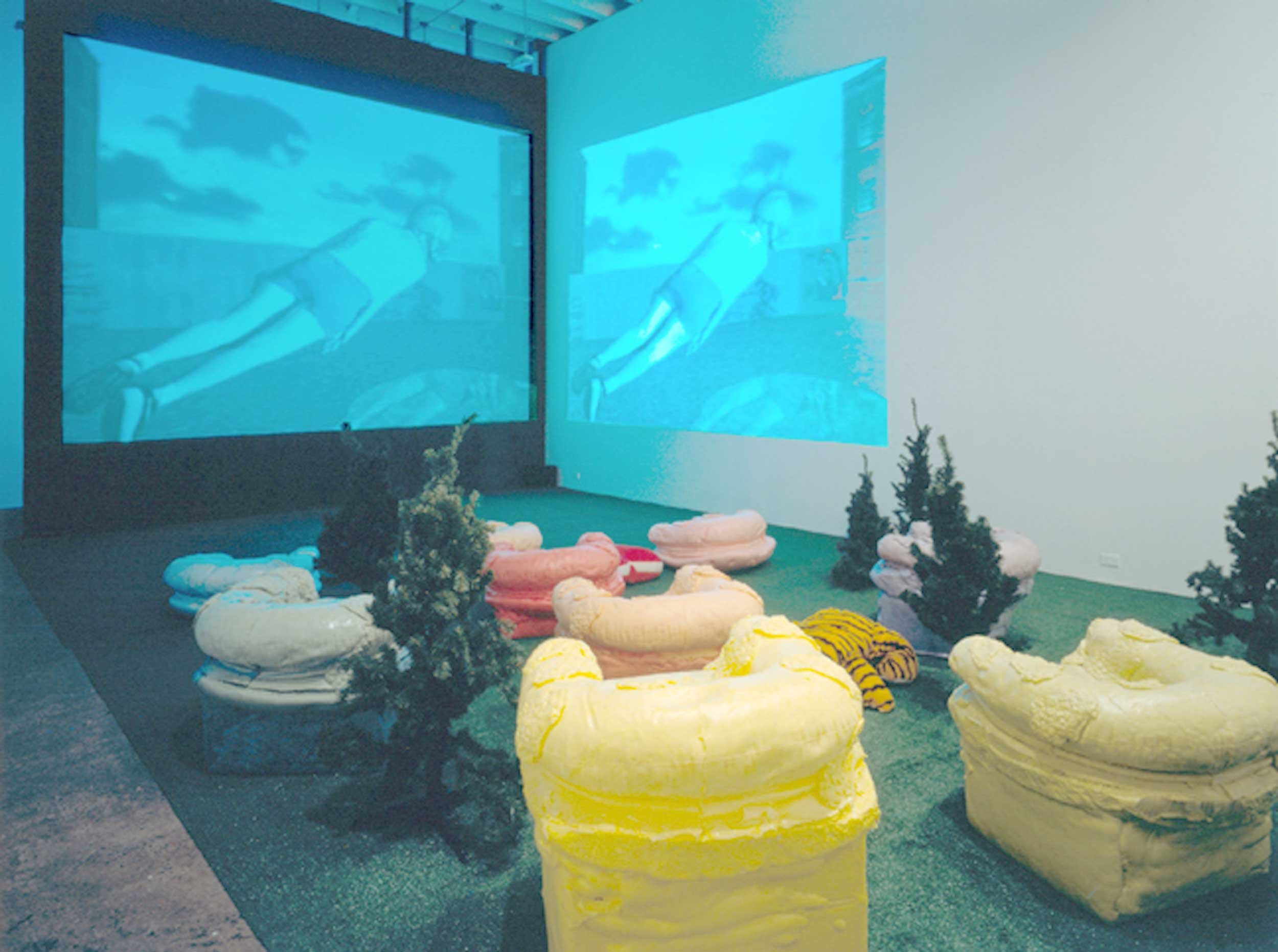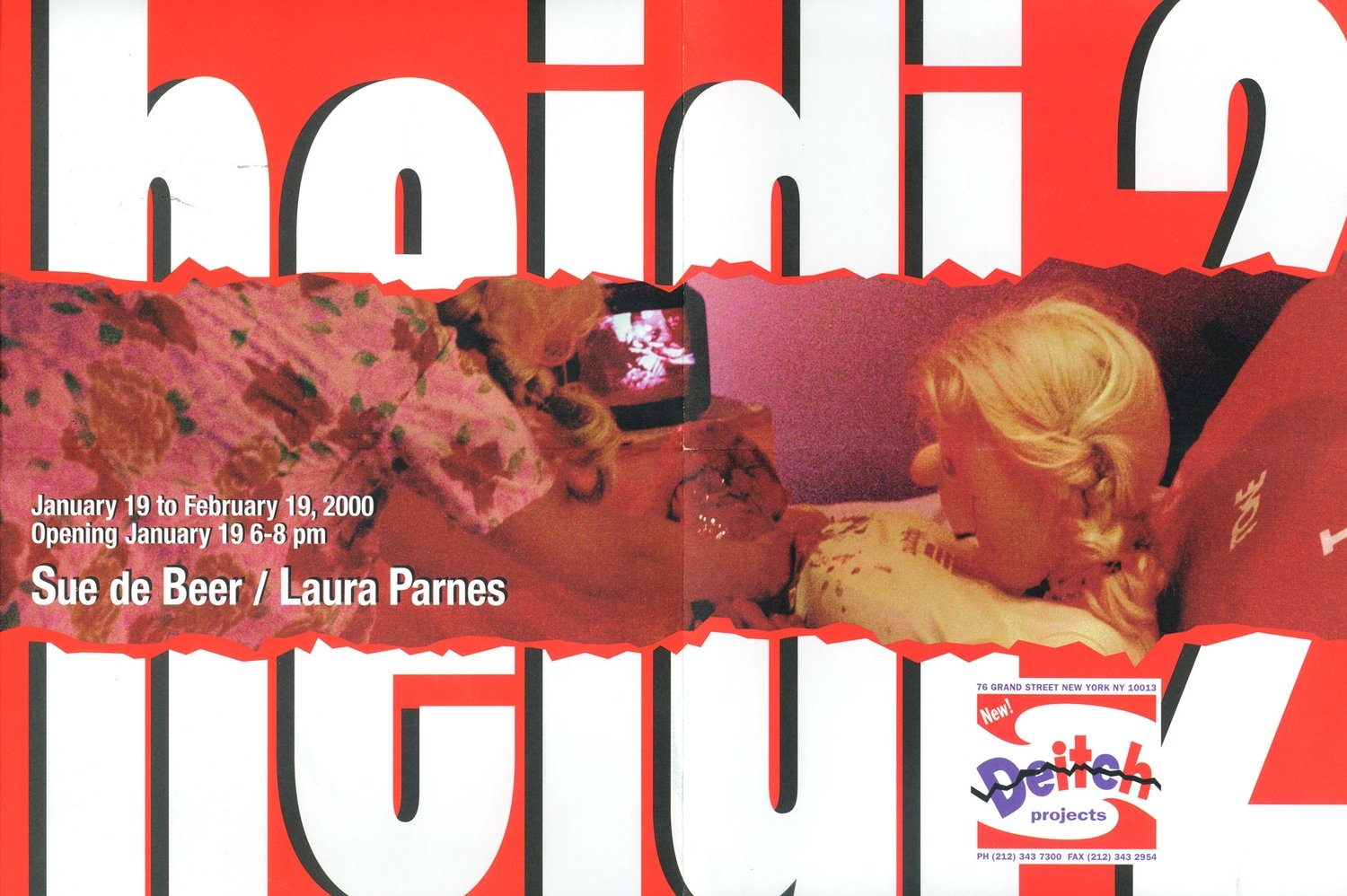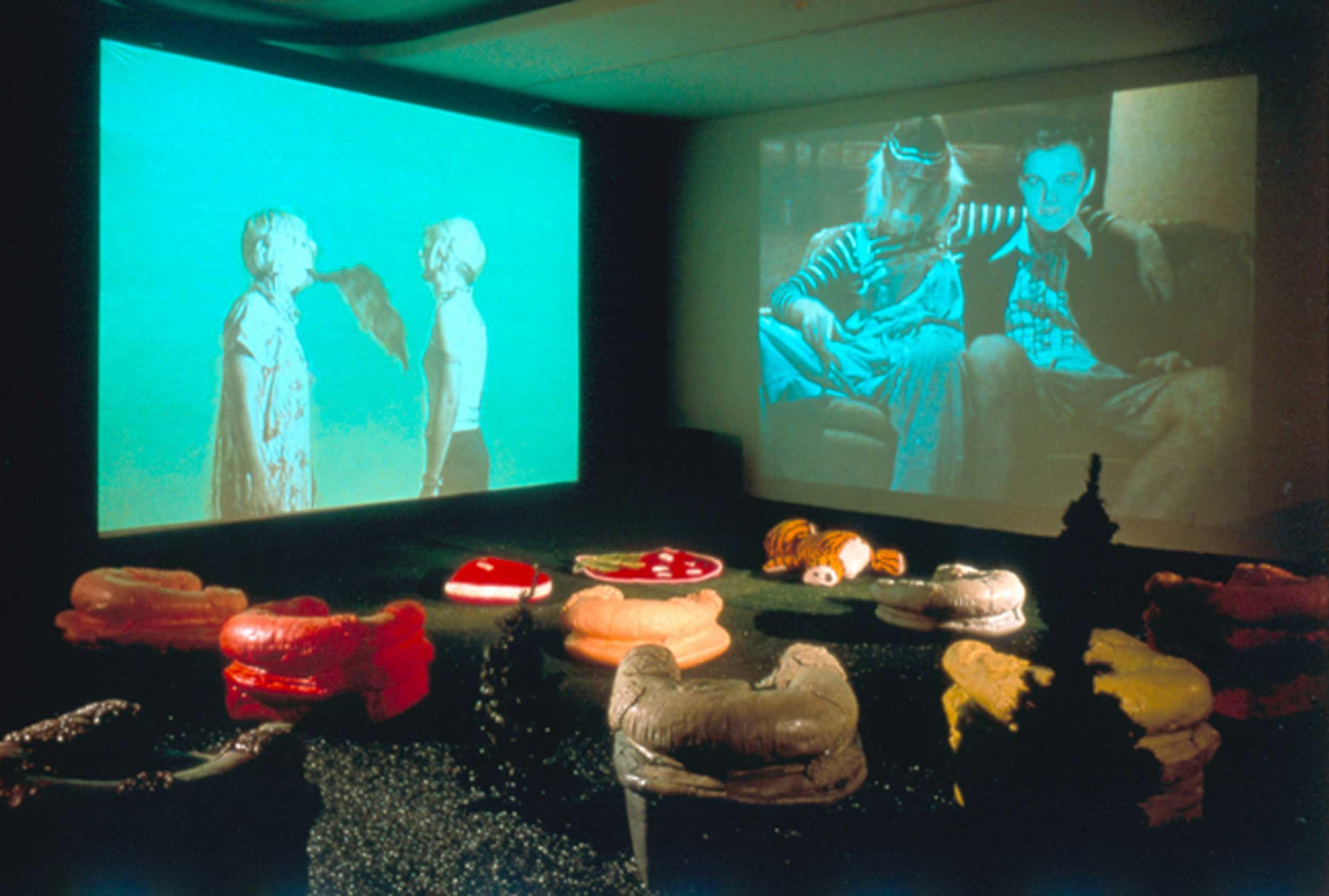HEIDI 2 (WITH LAURA PARNES)

Installation View of Heidi 2, at Deitch Projects, New York, 1999/2000
Heidi 2 was a 2-channel video installation, first shown at Deitch Projects in New York. This piece was made in collaboration with Laura Parnes.
Cathy Lebowitz interviews Josefina Ayerza: "Heidi 2, Sue de Beer and Laura Parnes"
Lacanian Ink 16
This is an interview with Josefina Ayerza about Sue de Beer and Laura Parnes' exhibition at Deitch Projects. It's called Heidi II and it's based on Mike Kelley and Paul McCarthy's Heidi. It's the unauthorized sequel.
THE BIRTH
C: So Josefina, what
happened first in the film?
J: Well, what happened first was this
birth. It was a big thing that happened. In the way it was presented. This
enormous vagina… very impressive. And also in the sense that this vagina
was so active in itself… so as to push this thing out of itself. And you
could see this activity there under your eyes. I liked the way they set up the
expectation… the time for something to appear… till the head pops
out. Of course I could see the rejection in the faces of other people, trying
to run away.
C: Because when the baby comes out, it's not a pretty
baby.
J: I was amazed to see this. I never saw my babies by the way,
because at this very instance there is no mirror in front of you when you have
a baby. You're just pushing. You don't see it in a mirror, that's the only way
to really see that moment. You can only see it in somebody else. In the movie,
it's a horrible thing that comes out, I would say.
C: Like an
alien.
J: Like an animal. It looked like a piggy I would say this
one.
C: So you think this vagina is Heidi's and she is having a baby
Heidi?
J: I was thinking is this a real thing? Is it a real vagina,
and is it a real photograph of a birth? Since I never saw a birth… I
think it is not true that it is so tremendous…
C: Wasn't the
vagina moving or talking? I don't remember. There were some words.
J:
The vagina I don't think was talking. There was a voice-over with words spoken.
But it was active, very active. Also I was impressed by the color, it was white
what came out of there.
C: The baby, you mean?
J: The baby is
inside of placenta. And you could see this.
THE INSTALLATION
C:
So what is the next scene after that.
J: I was very much watching these
diseases. I went back to look at the sofas and the diseases.
C:
Yes, this gallery installation with Astroturf carpet and stuffed tigers and
urethane foam seats.
J: I was thinking why are we sitting on the
disease. And I had to resolve it very quick, and think well we are sick because
we speak. I'm not sure if it was exactly the next scene but I remember when
she's in the cradle and she looks down and sees the doll. And she transforms
from herself into the doll.
HEIDI THE DOLL
C: Like the mirror
stage?
J: Well there is something before that I would say. When the
child is born, she is the mother. In the beginning she is the mother inside.
She really is. Then she is born. First there is something with the breast. And
the desire starts when you are tiny, when the lips move, when you are hungry
and there's the breast that the child stays with when they are not hungry at
all. This would be the breast of the desire. But I think the first moment when
they feel different from the mother is when the breast falls, when they don't
get breast fed anymore, something is taken away. And now they desire it…
You know desire is a lack of something.
C: In the movie they don't
show any of that, the nurturing mother, who feeds the baby.
J: I don't
remember any nurturing mother. What happens in the mirror stage is that she
sees her image and she believes this is she, although the image is different,
it's never the same. And she puts this image, like you put a dress, on top of
her. She invests, or revests, herself with this image. And she says this is me.
But maybe we could take that to the doll. In the film she invests herself with
that image of the doll, she becomes the doll - an image outside herself.
C:
What does she do that makes it seem that she invests herself in the doll?
J:
Well you see her turn into a doll. Her face turns into the doll. And also a
mask is very much something you put on. You dress your head as a mask and a
baby dresses himself with his own image. She dresses herself into a doll, this
is what she is in the film, right? I wonder why she called her Heidi. Maybe
because Paul McCarthy did, but Heidi is una campesina, you know, like a girl of
the wood, the mountains. But her doll could be Heidi. That's why I think she
could have called this Heidi. Maybe her doll was Heidi, like Shirley Temple or
Barbie.
C: In Kelley and McCarthy's Heidi, the men played important
roles, the grandfather and Peter. In this one, Heidi the mother and Heidi the
daughter play bigger roles.
J: I think it's much more about the relation
between mother and daughter, much as the other one was the relation to the
father. The drama here is with mother and daughter.
THE OPERATION
C: Let's talk about the last scene.
J: The mother tells her
to stab the stomach with this pen.
C: Why does the mother have her do
that?
J: She's stabbing her stomach and there's some juice
coming out, which could be ink, black ink. She writes and writes and writes,
and she makes a total mess. At some point she's finished. And the mother comes
and peels that off.
C: Peels off…?
J: No I think
more than peels it off, she takes a piece of the stomach, like opening the
door, and takes viscera out. And I was thinking it could be the heart, like a
Pinocchio. And what she says is "You have a sex or you have soul." So
she pulls this out, and puts the television in place of that.
C: Is
the television the soul?
J: I had another fantasy. She's pulling
out the soul, the heart, which is more connected to the soul, and saying have a
sex. But don't have a soul. It's like an advice; if you have a soul and a sex
you're doomed. I have no idea, but that's my interpretation. She puts in
a television, which is a cold technical thing, where everything tells a story,
but it's a cold apparatus there.
C: Television seems to play a
large role in the film. The grandfather is always watching the television.
Peter and the grandfather watch the television. And then she gets a
televisionSˇin her. That's kind of strange. She gets that thing that they
have been staring out through the movie inside of her. You see, I think this is
trying to invert all the things…
J: Invert the
theory.
C: So suddenly she has the desire of Peter and the grandfather
inside of her, almost like a phallus.
J: She becomes it, you say?
C:
She becomes what they are going to look at.
J: At the same time, you
know Pinocchio? He didn't have a heart. And then came the fairy to put the
heart in. But this one…
C: …gets the heart taken out.
J:
Well maybe the girl can look at the television, at whatever's happening
to her in there. She can look at the story. If she can look in her story, there
probably is a distance to not have a soul. I think that's a very good way to
put the message of the mother. You have a sex or you have a soul but if you
have both you are going to suffer too much.
THE AMERICAN ABJECT
C:
I wanted to ask you one more question. These artists are American. I wanted to
ask you about this whole abject esthetic. The abject.
J: To me it's a
Derrida word. It's very subjective, but if America brings something, it's the
esthetic of the jeans, let's say. Everybody has jeans. They uniformed the
world. And I think they are something everybody wants to have. Jeans are as
revolutionary as the Beatles, although the Beatles aren't abject. If you think
of fashion, Dior, Chanel, this small group of people directing fashion, I can't
think of something more abject. I think this is how the word works. I think now
there is another term going a little further. I think America has a lot to do
with the new esthetic. Like Coca-Cola for instance. America covers enormous
surfaces with these things. And these things are abject in the beginning. From
the diseased chairs they have you sit on. The birth, the throwing up, the
stomach of the girl. There is some disgust you go through. I like that
sensation. It goes together with opening up, it makes your scope
bigger.
C: Of your thought?
J: Of your possibilities? Let's
say you love someone, get close to the abject of that person. Just get close
and love it. The abject was hidden, covered. The American esthetic, it is a new
esthetic, it puts it there for you to love it.

Invitation to the show at Deitch Projects

Heidi 2, Installation View at LACE in LA, 2000
